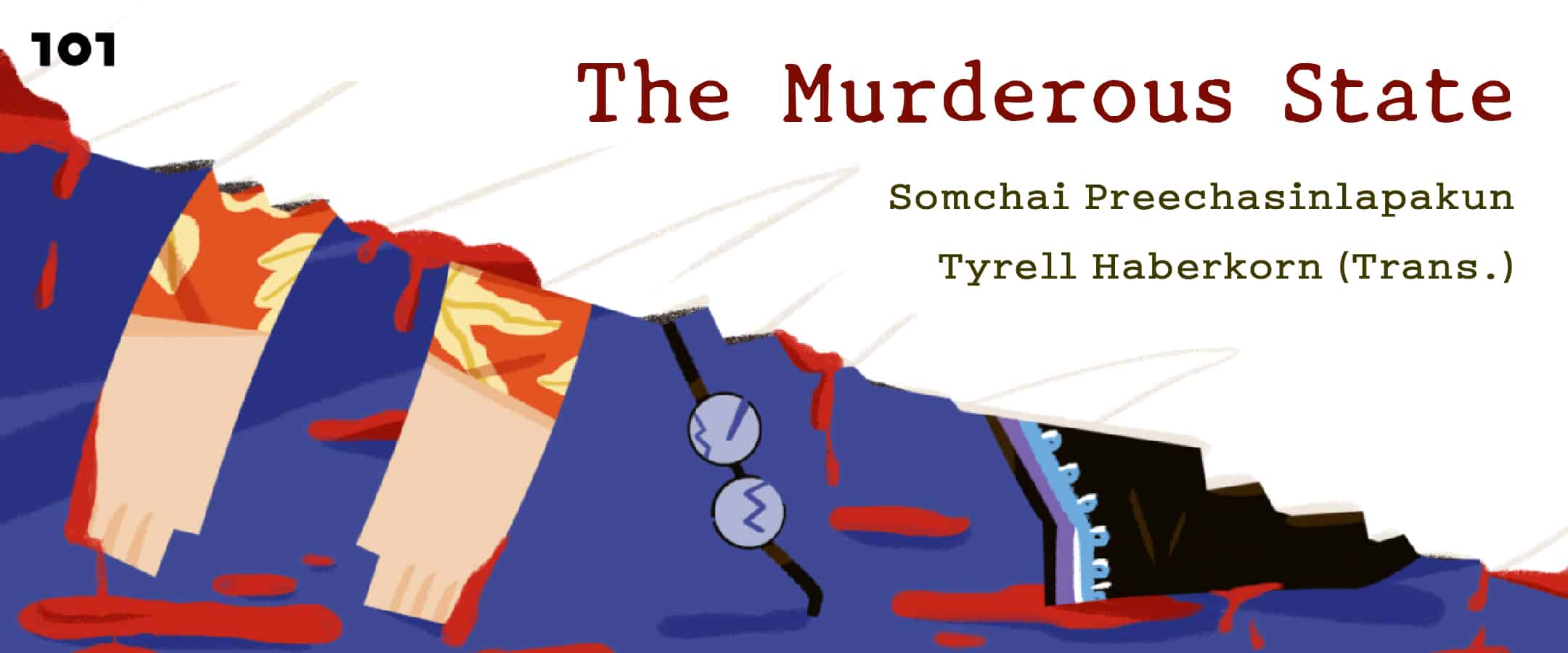written (in Thai) by Somchai Preechasinlapakun (June 2020)
translated by Tyrell Haberkorn (January 2021)
[box]
Note: Somchai Preechasinlapakun, associate professor in the Faculty of Law at Chiang Mai University, regularly writes for The 101 World about law, dictatorship and democracy. In this essay, he analyzes the Thai state apparatus as what he names a murderous state (รัฐฆาตกรรม), which is “a state that has the ability, mechanism, and preparedness at many levels to use deadly violence.” Somchai then breaks the kinds of violence the murderous state uses against the people into three types of killings: legal murder, extrajudicial killing, and internal power structure killing. Each of these types of killings represent different relationships of violence between the state and the people, but what they all share is the near impossibility of accountability. Those in the employ of the murderous state continue to kill because they are never held responsible.—Tyrell Haberkorn, translator.
[/box]
In this society, people have lost their lives at the hands of state power continuously and in many forms.
The state has enacted violence upon the people massed together for political reasons, such as in the case of the 6 October 1976, Black May 1992 and April-May 2010 massacres. But there is another category of unrelenting state violence in the form of the killing of individuals. This includes the killing of suspects while they are in the process of being arrested by the police, the assault or disappearance of people who oppose the state, and a number of other examples.
A significant amount of research has been completed about the exercise of state power and violence against citizens in mass killings. Attempting to understand this form of violence is necessary in order to protect against and avoid incidents in which criminals can remain in plain sight and murderers can get away with killing, especially when they are those who hold power in a given period.
However, we should also attempt to understand the forms of state violence that target individuals and small groups for non-political reasons, and which may take place in plain sight or may be concealed. Such deaths can be found in news reports on a daily basis. These incidents can be called everyday state violence.
I would like to refer to this as a characteristic of the murderous state, which refers to a state that has the ability, mechanisms, and preparedness at many levels to use deadly violence, whether openly or secretly. That will enable us to more fully comprehend the exercise of state violence against the people. In so doing, we will be able to identify many more forms of deadly state violence against the people in addition to the murder of those massed in large groups.
A Plurality of Murder
The first form is the violence of the state that is widely-known and called legal murder. This refers to the deaths of individuals whom the officials claim occurred while they were carrying out their civil service duties and the deaths of individuals when they are in the custody of officials who claim that they were carrying out their civil service duties. For example, shooting and killing suspects while they are being arrested, or suspects who die while they are in state custody, etc.
Legal murder in Thai society is often related to policy or a direction set by the government. For example, during the period when the government announced a war on methamphetamines [early 2002], a large number of people who were accused of being involved with drugs were killed in this way. Or the case of the legal murder of suspects who are accused of being ‘those who create unrest’ in the three southernmost border provinces, which is closely-related to the state’s method of governing the area.
In other words, the exercise of authority by state officials in legal murder is a kind of killing that has a goal behind it and is referred to in studies of state violence as ‘targeted killing.’ But it must be realized that setting goals that lead to people’s deaths is not the result of painting target symbols on the backs of given individuals, but is the effect of a state policy that stipulates that there are actions cast as violent ‘dangers.’ The setting of categories of actions as dangerous to the state leads to the creation of the opportunity for state officials, whether police or soldiers, to use violence against the people without being investigated. Or, if there is an investigation and it is found that wrongdoing has occurred, the perpetrator will not face harsh punishment.
Another kind of murder that is closely related to the exercise of state power but may lack clear evidence of this relation is extrajudicial killing. This includes, for example, the assassination of important individuals, the disappearance of people who oppose state power, which may arise both inside and outside the country, especially where there are good relations with the country where the dissident resides, etc. But this form of murder exists outside the norm and cannot easily be mentioned in public. So, significant attempts to concealing the traces of state involvement, including denial of the involvement of state units, are made.
But it is well-known that it is difficult for this kind of murder to arise without the cooperation or involvement of state agencies. Extrajudicial killing cannot result solely from the exercise of power by ordinary state officials, but requires coordination by high-level state power to make all state mechanisms function, or fail to function, in unison. The assassination of a former yellow shirt leader in the middle of the city many years ago through such impenetrable, even up until today, collaboration, is one such example.
It is clear that extrajudicial killing tends to arise under authoritarian regimes.
In addition to the aforementioned kinds of deaths, another form of killing in which state officials have a role is what can be called internal structural power killings. Such killings are those closely-related to mechanisms of state power. Examples include the deaths of low-ranking soldiers or conscripts on military bases, the deaths of cadet school students while they are training, etc.
These deaths are not murders that are directed by government policy or the official policy of a given security agency. The individuals involved in the murder may be ordinary-level officials with no need to be those with a large amount of power. When such a murder arises, the explanation often given is that there is a personal reason behind it or it resulted from an individual deficiency, not that it is the policy or desire of any given involved unit.
Consider the explanation given for the death of the cadet school student who lost his life from being beaten up by his seniors in 2017. The beating punishments inflicted on the juniors by their seniors is an example that demonstrates the denial of the involvement of state power.
However, even though it may not be a goal set by state policy, these murders are an effect of the power structure that functions within a given unit. The victim is in the position opposite to power and has no ability to negotiate. This includes, for example, the relationship between military officers and low-ranking soldiers, that between the commander and those under his command, and that between seniors and juniors. This is a factor that supports the emergence of deadly violence.
It is important to remember that the deaths which are known are only the tip of the iceberg. A great deal more violence remains hidden.
Murder Without Accountability
Deaths arising from the actions of the murderous state nearly never result in the involved individuals or units being held to account.
In the case of the legal murder of Joe Danchang and 6 people in 1996, the police claimed that they resisted while they were being taken back to the scene of the crime to search for additional evidence. The deaths arose even though the police were able to take the suspects into custody and handcuff them. All were shot and killed at the scene of the crime with no state official being clearly held responsible. What instead became clear was that the high-ranking commander in this operation was continually promoted.
Chaiyaphum Pasae (an ethnic activist) was shot and killed by soldiers at a checkpoint in 2017. The soldiers claimed that he resisted arrest. A high-ranking commander in the area gave an interview after seeing the CCTV footage and said that he, too, would have shot Chaiyaphum. But when the lawyer for the family of the deceased requested stills of the CCTV footage, the military unit denied that there was any footage.
These kinds of killings are not limited to those who are accused of being criminals, such as Joe Danchang, or those who are marginalized, like Chaiyaphum Pasae. The cadet school student was part of the urban middle-class. When his relatives fought for accountability, they faced a significant amount of difficulty in ensuring that the corpse was examined to find the cause of death without those who held power becoming aware that they were doing so. Even though three years have passed, there has been no conclusion to the case. The end result can be predicted without any difficulty.
The examples raised are only a tiny fragment of the phenomenon of killings by the murderous state in this society.
Often the understanding in the present is that the law and system of state power provide protection to the right to life of the people securely without giving permission to the state to exercise power to eliminate people in a barbaric way. The judicial process has undergone significant development in the preceding decades. Many units and mechanisms to protect the rights and freedoms of the people have flooded the cities, including the National Human Rights Commission, the Ombudsman, the Office of People’s Legal Aid from the Court and Public Prosecutor, the Lawyers’ Council, the Rights and Liberties Protection Department, the Justice Fund, and many more units.
But the role of these organizations may be limited to only cases when violence arises between the people. When one of the parties to the conflict is the state, especially in cases of deadly violence, the legal system and judicial process are able to stand stock still in unison.
All of this reflects the despite the picture that the legal system and the Thai state power structure appear to place importance on the rights and freedom of the people, in truth there is a ‘murderous state’ that stands and directs from behind. This murderous state is prepared to act whenever confronted by challenges that may shake its legitimacy and power.



